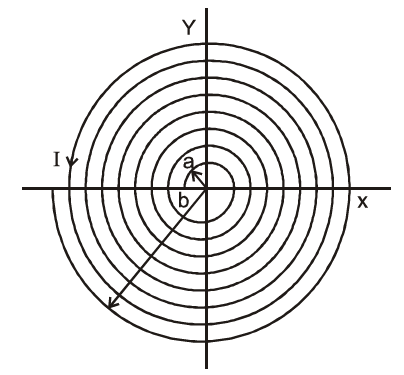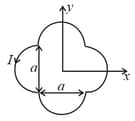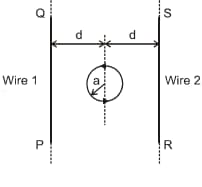A long insulated copper wire is closely wound as a spiral of turns. The spiral has inner radius and outer radius. The spiral lies in the X-Y plane and a steady current I flows through the wire. The Z component of the magnetic field at the center of the spiral is



Important Questions on Magnetic Effect of Current
A loop carrying current I lies in the x-y plane as shown in the figure. the unit vector is coming out of the plane of the paper. the magnetic moment of the current loop is :

The figure shows a circular loop of radius a with two long parallel wires (numbered and ) all in the plane of the paper. The distance of each wire from the centre of the loop is . The loop and the wires are carrying the same current . The current in the loop is in the counterclockwise direction if seen from above.

Consider , and the loop is rotated about its diameter parallel to the wires by from the position shown in the figure. If the currents in the wires are in the opposite directions, the torque on the loop at its new position will be (assume that the net field due to the wires is constant over the loop)
A conductor (shown in the figure) carrying constant current is kept in the plane in a uniform magnetic field . If is the magnitude of the total magnetic force acting on the conductor, then the correct statement(s) is (are)

A charged particle (electron or proton) is introduced at the origin with a given initial velocity. . A uniform electric field and a uniform magnetic field exist everywhere. The velocity , electric field and magnetic field are given in column and , respectively. The quantities are positive in magnitude.
| Column-1 | Column-2 | Column-3 | |||
| (I) | Electron with | (i) | (P) | ||
| (II) | Electron with | (ii) | (Q) | ||
| (III) | Electron with | (iii) | (R) | ||
| (IV) | Electron with | (iv) | (S) |
In which case will the particle move in a straight line with constant velocity ?
A charged particle (electron or proton) is introduced at the origin with a given initial velocity. . A uniform electric field and a uniform magnetic field exist everywhere. The velocity , electric field and magnetic field are given in column and , respectively. The quantities are positive in magnitude.
| Column-1 | Column-2 | Column-3 | |||
| (I) | Electron with | (i) | (P) | ||
| (II) | Electron with | (ii) | (Q) | ||
| (III) | Electron with | (iii) | (R) | ||
| (IV) | Electron with | (iv) | (S) |
In which case would the particle move in a straight line along the negative direction of axis, (i.e, move along )?
